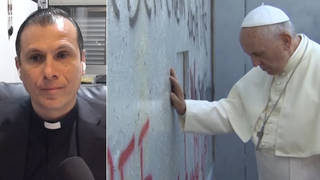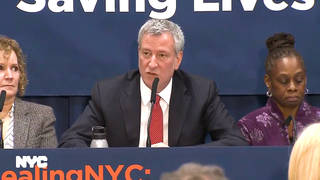
Guests
- Brendan Johnsonpartner with the law firm Robins Kaplan and chair of its American Indian Law and Policy Group.
- Stacy Bohlenchief executive officer of the National Indian Health Board. She is a citizen of the Sault Ste. Marie Tribe of Chippewa Indians.
A group of more than 500 cities, counties and Native American tribes have filed a lawsuit against members of the Sackler family for their role in creating “the worst drug crisis in American history” by lying about the dangers of the opioid painkiller OxyContin and deceitful marketing of the drug. The lawsuit differs from others that target drug companies, because it names eight members of the Sackler family, which founded and owns Purdue Pharma, the maker of OxyContin. We speak with attorney Brendan Johnson, partner with the law firm Robins Kaplan and chair of its American Indian Law and Policy Group, about the federal lawsuit he filed on behalf of three Native American tribes from the Dakotas against major opioid manufacturers and distributors. We are also joined by Stacy Bohlen, CEO of the National Indian Health Board and a citizen of the Sault Ste. Marie Tribe of Chippewa Indians.
Transcript
AMY GOODMAN: This is Democracy Now! I’m Amy Goodman, as we turn to look at how a group of more than 500 cities, counties and Native American tribes have filed a lawsuit against members of the Sackler family for their role in creating, quote, “the worst drug crisis in American history,” unquote, by lying about the dangers of the opioid painkiller OxyContin and deceitful marketing of the drug. The lawsuit was filed last week in the Southern District of New York and differs from other lawsuits that targeted drug companies, because it names eight members of the Sackler family, which founded and owns Purdue Pharma, the maker of OxyContin. Opioid overdoses are responsible for nearly 50,000 deaths per year in the United States, and the Centers for Disease Control and Prevention found Native Americans have suffered the largest increase in overdose deaths.
For more, we’re joined in Sioux Falls, South Dakota, by attorney Brendan Johnson, partner in the law firm Robins Kaplan and chair of their American Indian Law and Policy Group. Earlier this year, he filed a federal lawsuit on behalf of three Native American tribes from the Dakotas against major opioid manufacturers and distributors. Johnson is the former U.S. attorney for South Dakota. And in Washington, D.C., Stacy Bohlen is with us, the chief executive officer of the National Indian Health Board. She’s a citizen of the Sault Ste. Marie Tribe of Chippewa Indians.
Brendan Johnson and Stacy Bohlen, we welcome you both to Democracy Now! Brendan, lay out your lawsuit.
BRENDAN JOHNSON: Right. Well, first of all, it’s an honor to be here, and thank you for putting attention on this important issue.
So, our lawsuit, in terms of the legal claims and the facts, are not dissimilar from several of the other lawsuits that you’ve discussed this morning, in that we are targeting the prescription drug companies that we feel like inappropriately marketed this product. Where ours are different, where our lawsuits are different, of course, is we are just representing Indian tribes. Indian tribes, as you heard earlier this morning, have been disproportionately affected. And this is something that I saw while I was U.S. attorney in South Dakota. As we would go from tribal community to tribal community, what we would consistently hear is about how these opioid—the opioids had really affected the community, about the high rates of addiction, both amongst the elderly as well as the young. Really, there wasn’t a consistent demographic.
And, unfortunately, what we’ve seen is, this problem continued to escalate, as we outline in our complaint, in that now we’re seeing more and more Native American children that are being born addicted to opioids. And it’s creating—really wreaking a lot of havoc in tribal communities, even to the point now where we’re seeing more Native American children who wind up being put up for adoption as a result of having parents that are addicted to opioids. So, this threat to tribal communities across the United States, not just in South Dakota, is really an existential one.
AMY GOODMAN: So, can you talk specifically about the Native American nations, the tribes that you’re representing?
BRENDAN JOHNSON: Right. So, what we’ve seen with the tribes is that the impact has been significant. The tribes, of course, range from, for example, Pine Ridge, which is one of our clients, that has over 40,000 members, to some of our tribes that have 200 to 300 members. Each of them has been impacted significantly. And so, first of all, oftentimes we’re talking about some of the most strained economies in the country, where you’ll see unemployment rates of 80 percent. You’ll see already high rates of drug and alcohol addiction. But now, when you layer the opioid epidemic on it, it is having this profound impact on these communities, that, frankly, oftentimes, too, don’t have any sort of resources when it comes to drug treatment centers. So you have people oftentimes in rural, isolated communities without access to drug treatment programs. And this, again, is affecting the elderly; it’s affecting men, women, children. It really knows no bounds within these communities and poses a real threat for the future of our tribal communities in America.
AMY GOODMAN: Can you compare this lawsuit to taking on Big Tobacco?
BRENDAN JOHNSON: Well, and our law firm was one of the leaders in Big Tobacco. And, you know, Amy, one of the biggest differences, and one thing that tribes should feel real proud about here, now, I think, is, when it came to Big Tobacco, when our law firm, we represented the state of Minnesota in that case, tribes didn’t have a seat at the table. And that’s how it’s often been for tribes over the last 200 years. What is different here is that tribes do have a seat at the table, have been very aggressive in their claims, because oftentimes the state and the state attorney generals—too often, the tribal communities are forgotten. And here, that won’t be the case. And so I think that’s the biggest difference, is that tribes are involved, whereas with Big Tobacco they were not.
AMY GOODMAN: I want to turn now to Stacy Bohlen, chief executive officer of the National Indian Health Board, citizen of the Sault Ste. Marie Tribe of Chippewa Indians. According to the Centers for Disease Control and Prevention, between ’99 in 2015 Native Americans had the largest increase in overdose deaths compared to other groups. Why, Stacy, have Native Americans been hit so hard by the opioid crisis?
STACY BOHLEN: First of all, thank you for having me on the show. It’s a real honor for the National Indian Health Board to be here.
I think there are a lot of complex reasons why this crisis has hit Indian country harder than other places, but those reasons translate to all of the other health disparities and health challenges that tribes face, as well. I think that you’re looking at very vulnerable populations of people who have a relationship with the federal government through the treaties, the trust responsibility, and have very vulnerable healthcare systems, that are funded below 50 percent of need despite those funds being promised through treaties, law and the political status of our people through the U.S. Constitution. So, you are dealing with rural and remote America in many cases. However, I think one of the foundational issues that’s really important to understand is that because of our status as sovereign nations and our relationship with the federal government, when funding is brought from Congress through state block grants to fight the opioid crisis, the states are under no obligation to share any of that funding with tribes, because the relationship is with the federal government.
So, I think you have a number of circumstances conspiring. One is structural. One is unmet promises to Native people, that have existed before the existence of this country. One is communities that live with the trauma, postcolonial trauma, that they have experienced in their own ways, their own unique ways. You know, and there are a number of ways to address the crisis, but I think those are some of the elements of why it’s hit our people so hard.
AMY GOODMAN: Can you link this, Stacy Bohlen, to the number of medical students and—Native American medical students and doctors?
STACY BOHLEN: Absolutely. I think one of the greatest challenges that Indian country faces is we lack healthcare providers in a very profound way. We have vast openings for physicians, dentists, behavioral health professionals, substance abuse professionals. Every ethnicity in the United States, every sort of group of people in the U.S. who attend medical school, all of their numbers are increasing for the number of graduates of medical school. Ours are actually declining. And that’s declining from a number that was already not representative of our people. We had 11 graduates of medical schools last year, and I believe the number was five the year before. It’s very low, very challenging to get our people into medical schools and get them graduated. Actually, we have high acceptance rates, but the way to fund being a medical student and the kind of supports that an individual needs to be successful are absent in our communities.
AMY GOODMAN: Can you talk about how tribes have taken matters into their own hands in dealing with the opioid epidemic? You’ve testified before Congress. What are you calling for?
STACY BOHLEN: Well, first of all, we worked very hard to educate members of Congress about the fact that the great work they were doing to attempt to fund this crisis in America was not reaching our people. And we did have some success in getting earmarked funding, $50 million in 2018 and 2019, to go directly to tribes to help with this crisis. So we were very grateful for that. That needs to continue and increase.
We also call for more healthcare providers in our communities who are well qualified to help in these kind of crisis situations. We need economic development investment. You have heard the statistics. Some of our communities have up to 80 percent unemployment. That creates a foundation of vulnerability that impacts every aspect of life. And while this economic current status is being talked about as how strong our economies are in this country, that’s not reaching Indian country, either. So, I think the number one disease that our people suffer from is anonymity or invisibility. People don’t think about Indians. They don’t have knowledge of the treaties that exist in the social contract between the U.S. government and the many Indian nations.
But some of the tribes are able to use their own resources to create clinics, to partner with local and state governments, when possible. Washington state—tribes in Washington state, led by the Swinomish Tribe, are doing an excellent job of creating clinical opportunities for people to receive drug treatment, drug counseling and preventative measures. So, in Arizona, in—throughout the country, you’re seeing tribes have an insurgence of returning to cultural ways of knowing and cultural ways of treating addiction and a revitalization of those cultures as part of the answer that is successful for our people. But we need more investment.
AMY GOODMAN: Stacy Bohlen, I want to thank you for being with us and helping to make what has been invisible visible.
STACY BOHLEN: Thank you.
AMY GOODMAN: CEO of the National Indian Health Board, citizen of the Sault Ste. Marie Tribe of Chippewa Indians. And to Brendan Johnson, thank for joining us from South Dakota, chair of the American Indian Law and Policy Group of his law firm.













Media Options